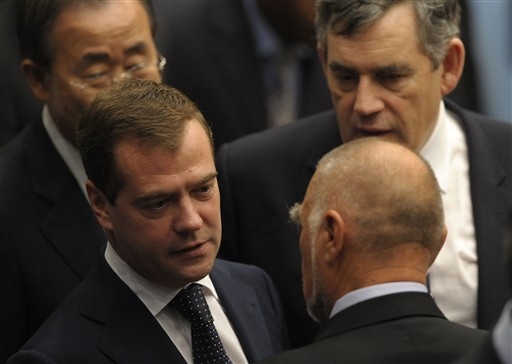
Moscow Targeting Adriatic Energy Transportation Lifeline to Central Europe
Publication: Eurasia Daily Monitor Volume: 6 Issue: 233
By:

Russian President Dmitry Medvedev and Prime Minister Vladimir Putin received Croatia’s outgoing president, Stjepan Mesic, in Moscow for a valedictory visit on December 13-14 (Interfax, December 14). The discussions focused on energy issues, reflecting Moscow’s preparations for a breakthrough into the Croatian oil and gas sector. The Russian leaders treated Mesic’s visit as an opportunity to prepare Croatian Prime Minister Jadranka Kosor’s Moscow visit, scheduled tentatively for January 2010 and expected to concentrate on energy issues.
Croatia has been largely free of a Russian presence in its energy sector thus far. While Croatia’s small energy market can hardly interest Russia’s oil and gas giants from a business perspective, Croatia’s location on the Adriatic coast is what interests the Kremlin. If Russian state-connected companies acquire stakes in the Croatian energy transportation infrastructure, they could cut off several Central European countries from non-Russian energy supplies delivered to Adriatic ports. In that case, Hungary and some of its neighbors would lose their main chance to diversify their energy import options away from overdependence on Russia. This would then open the way for Russian expansion into those countries’ energy systems.
Mesic, who is now completing his final presidential term, briefed Prime Minister Kosor and Croatian media on some details of his discussions in Moscow regarding oil and gas. On December 16 the Russian Ambassador to Croatia, Robert Markarian, visited Mesic in Zagreb to convey the Russian leaders’ satisfaction with the talks just held (HINA, Vjesnik, Jutarnji List, Poslovni Dnevnik, December 16, 17; Politika [Belgrade], December 17).
In Croatia’s oil sector, the Russian side wants to acquire a stake in the Adriatic Oil Pipeline (JANAF), which runs from the port of Omisalj across Croatia’s territory to northern Hungary. The line’s traditional function is to carry Middle Eastern oil into central and southeastern Europe. The Russian government has long sought to reverse the pipeline’s direction, so as to use it for Russian oil exports from the Adriatic Sea (Moscow succeeded with a similar idea on Ukraine’s Odessa-Brody pipeline, which is being reverse-used to carry Russian oil for export through the Black Sea, instead of the original function to carry non-Russian oil into Ukraine and Poland).
Russia’s Lukoil and GazpromNeft companies have recently discussed plans with JANAF to enlarge storage capacities for Russian crude oil and derivatives in the Omisalj area and, on that basis, open an international spot market there (Vjesnik, December 7). Additionally, GazpromNeft lays claim –which Putin raised with Mesic– to some 30 filling stations and other property of the Croatian INA company, the main stakeholder in which is Hungarian MOL.
In the gas sector, the Kremlin proposes to build an extension of the South Stream pipeline system through Croatia (still without identifying the supply source). Chiding the previous Croatian government for its skepticism about this project, Putin and Gazprom are now offering a second-“best” solution –namely, a branch-off pipeline that would terminate in Croatia, rather than transiting Croatia along the main route. Russian Energy Minister Sergei Shmatko and Gazprom Vice-President Aleksandr Medvedev are also urging Zagreb to “work fast” and prepare with Russian experts an agreement on South Stream, for signing during Prime Minister Jadranka Kosor’s Moscow visit. In that case, Russian President Dmitry Medvedev would visit Croatia shortly afterward (Interfax, December 17).
In its earlier discussions with Zagreb (and other parties), Gazprom had asked to use the existing in-country transmission pipelines in the context of South Stream. Thus, Gazprom had hinted at using Croatian Plinacro’s pipeline link under construction toward Hungary –as well as using a Bulgarian transmission pipeline– for South Stream, which could prevent their use for the NETS project or Nabucco, respectively.
Should Gazprom enter Croatia through South Stream, it would likely press for halting the LNG project on Croatia’s Krk Island. That project (and Plinacro’s pipeline) is intended for liquefied gas of Middle Eastern provenance to be delivered via the Adriatic coast to landlocked Central European countries. Like the Adriatic Oil pipeline, it is a crucial supply diversification project for the region.
Croatia’s previous government, headed by Ivo Sanader who resigned in mid-2009, had demonstrated a fairly clear vision of energy security requirements for the country and the region. That government declined to join South Stream, resisted the reversal of the Adriatic Oil pipeline, and realized the importance of the Krk LNG project. Moscow did not hide its displeasure with the Sanader government, and then made a show of warming up to the successor prime minister Kosor. The Kremlin also played up to Mesic’s rivalry with Sanader when receiving Mesic on his valedictory visit.
The challenge to Croatia’s current government, its president to be elected, and the European Union is to preserve and develop the Adriatic energy transportation lifeline to Central Europe, rather than allowing its derailment by the Kremlin.




